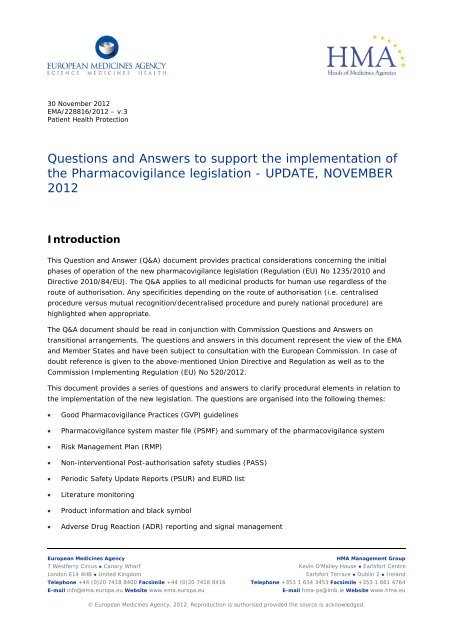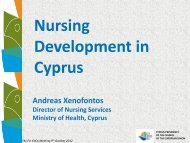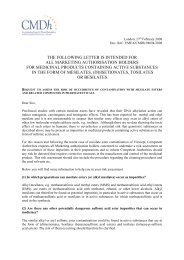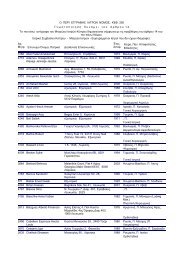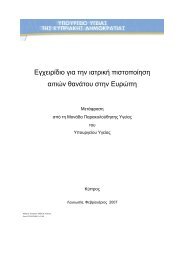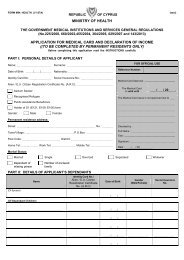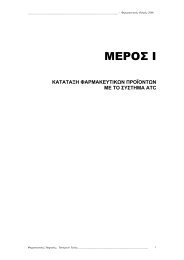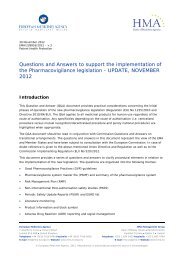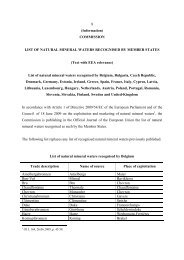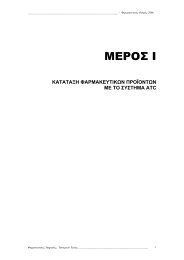Questions and Answers to support the implementation of - European ...
Questions and Answers to support the implementation of - European ...
Questions and Answers to support the implementation of - European ...
Create successful ePaper yourself
Turn your PDF publications into a flip-book with our unique Google optimized e-Paper software.
If available, <strong>the</strong> PSMF number assigned by <strong>the</strong> extended EudraVigilance Medicinal Product Dictionary(XEVMPD) should be included in <strong>the</strong> statement (see question 2.14). Applicants/MAH are encouraged <strong>to</strong>request a PSMF number (MFL EVCODE) for <strong>the</strong>ir PSMF in advance <strong>of</strong> <strong>the</strong> relevant applicationintroducing <strong>the</strong> PSMF (marketing authorisation, renewal or variation applications) in order <strong>to</strong> include<strong>the</strong> PSMF number in <strong>the</strong>ir application under Module 1.8.1; however this information is not part <strong>of</strong> <strong>the</strong>compulsory elements as per Article 8(3)(ia) <strong>of</strong> Directive 2001/3/EC.For fur<strong>the</strong>r information on <strong>the</strong> PSMF number (MFL EVCODE) please see question 2.14 <strong>of</strong> this document.In order <strong>to</strong> introduce <strong>the</strong> pharmacovigilance system summary in <strong>the</strong> marketing authorisation, <strong>the</strong> MAHshould submit a variation. The classification <strong>of</strong> <strong>the</strong> variation will be defined in <strong>the</strong> revised variationclassification guideline. Pending <strong>the</strong> publication <strong>of</strong> <strong>the</strong> revised variation classification guideline, <strong>the</strong> type<strong>of</strong> variation has been defined through an Article 5 procedure in accordance with Regulation (EC) No1234/2008. For more information, please see question 2.4.2.4. As <strong>the</strong> revised variation classification guideline is not yet available,what type <strong>of</strong> variation should I submit <strong>to</strong> include <strong>the</strong> pharmacovigilancesystem summary? (Update November 2012)Pending <strong>the</strong> publication <strong>of</strong> <strong>the</strong> final revised variation classification guideline, <strong>the</strong> CMDh issued arecommendation on classification <strong>of</strong> two unforeseen variations in accordance with Article 5 <strong>of</strong>Regulation (EC) No 1234/2008 one for <strong>the</strong> introduction <strong>of</strong> <strong>the</strong> pharmacovigilance system summary <strong>and</strong><strong>the</strong> o<strong>the</strong>r for changes <strong>to</strong> <strong>the</strong> QPPV names <strong>and</strong> contact details <strong>and</strong> <strong>to</strong> <strong>the</strong> PSMF location which can befound on <strong>the</strong> CMDh website. These are classified as type IAIN variation <strong>and</strong> are applicable <strong>to</strong> bothcentrally authorised products <strong>and</strong> products authorised through <strong>the</strong> mutual <strong>and</strong> decentralisedprocedures.Changes <strong>to</strong> <strong>the</strong> QPPV information can be introduced as part <strong>of</strong> <strong>the</strong> first introduction <strong>of</strong> <strong>the</strong>pharmacovigilance system summary in one single variation type IAIN, as <strong>the</strong> QPPV information is par<strong>to</strong>f <strong>the</strong> required information in <strong>the</strong> summary. If <strong>the</strong> QPPV information is changed as part <strong>of</strong> <strong>the</strong>introduction <strong>of</strong> <strong>the</strong> summary <strong>of</strong> <strong>the</strong> pharmacovigilance system, <strong>the</strong> MAH should clearly indicate <strong>the</strong>change in <strong>the</strong> application form (i.e. in <strong>the</strong> present/proposed table <strong>of</strong> <strong>the</strong> application form).The transition period <strong>to</strong> introduce, voluntarily, <strong>the</strong> summary <strong>of</strong> <strong>the</strong> pharmacovigilance system appliesper marketing authorisation (outside <strong>of</strong> <strong>the</strong> m<strong>and</strong>a<strong>to</strong>ry introduction at time <strong>of</strong> renewal), <strong>the</strong>refore it isup <strong>to</strong> <strong>the</strong> MAH <strong>to</strong> decide whe<strong>the</strong>r <strong>to</strong> introduce <strong>the</strong> summary <strong>of</strong> pharmacovigilance system for eachproduct at different times or <strong>to</strong> introduce <strong>the</strong> summary for several products at <strong>the</strong> same time. Once aproduct is included in a PSMF, <strong>the</strong> relevant type IAIN should be submitted <strong>to</strong> update <strong>the</strong> MA for thatproduct <strong>and</strong> <strong>to</strong> reflect <strong>the</strong> switch <strong>to</strong> <strong>the</strong> PSMF for <strong>the</strong> product concerned.2.5. Can I submit a ‘one-<strong>of</strong>f’ grouped variation <strong>to</strong> introduce <strong>the</strong>pharmacovigilance system summary for all my medicinal products acrossall <strong>the</strong> Members States? (Update November 2012)Article 7.2(a) <strong>of</strong> Regulation (EC) No 1234/2008 sets out <strong>the</strong> possibility for a marketing authorisationholder <strong>to</strong> group several Type IA/IA IN variations under a single notification <strong>to</strong> <strong>the</strong> same relevantauthority. For instance one Type IA or IA IN affecting several medicinal products can be grouped for <strong>the</strong>same MAH. Please see EMA post-authorisation procedural advice – Grouping <strong>of</strong> variations.The same grouped variation may be used <strong>to</strong> introduce a summary <strong>of</strong> <strong>the</strong> pharmacovigilance system forseveral medicinal products with or without a DDPS. In that case, <strong>the</strong> information on which product has<strong>Questions</strong> <strong>and</strong> <strong>Answers</strong> <strong>to</strong> <strong>support</strong> <strong>the</strong> <strong>implementation</strong> <strong>of</strong> <strong>the</strong> Pharmacovigilancelegislation - UPDATE, NOVEMBER 2012EMA/228816/2012 Page 5/29
2.8. Can I introduce <strong>the</strong> summary <strong>of</strong> <strong>the</strong> pharmacovigilance system within<strong>the</strong> annual renewal application for my conditional marketing authorisationin <strong>the</strong> centralised procedure?The summary <strong>of</strong> <strong>the</strong> pharmacovigilance system should be submitted as part <strong>of</strong> <strong>the</strong> annual renewalapplication for a conditional marketing authorised through <strong>the</strong> centralised procedure in accordance withArticle 14(7) <strong>of</strong> Regulation (EC) 726/2004.2.9. Can I introduce <strong>the</strong> summary <strong>of</strong> <strong>the</strong> pharmacovigilance system withinmy extension application in accordance with <strong>the</strong> Annex I <strong>of</strong> Regulation (EC)No 1234/2008? (Update July 2012)The summary <strong>of</strong> <strong>the</strong> pharmacovigilance system is generally expected <strong>to</strong> be submitted as a groupedvariation with <strong>the</strong> extension application. For Mutual Recognition/Decentralised procedures, where <strong>the</strong>extension will lead <strong>to</strong> a new marketing authorisation, <strong>the</strong> summary <strong>of</strong> <strong>the</strong> pharmacovigilance systemcan be included in <strong>the</strong> extension application.2.10. What information will be made public on <strong>the</strong> EU web-portal regardingpharmacovigilance contact details <strong>and</strong> PSMF locations? Will details <strong>of</strong> <strong>the</strong>QPPV be made public?Article 26(1)(e) <strong>of</strong> <strong>the</strong> Regulation (EC) No 726/2004 places a responsibility on <strong>the</strong> EMA, in collaborationwith Member States, <strong>to</strong> make public, at least, a list <strong>of</strong> <strong>the</strong> locations in <strong>the</strong> Union wherepharmacovigilance system master files are kept <strong>and</strong> contact information for pharmacovigilanceenquiries, for all medicinal products for human use authorised in <strong>the</strong> Union. On this basis:‣ Pharmacovigilance enquiriesEMA will publish contact information for pharmacovigilance enquiries from <strong>the</strong> data submitted underArticle 57(2) <strong>of</strong> <strong>the</strong> Regulation (EC) No 726/2004, as follows:• email address for pharmacovigilance enquiries (Art 57(2) data field AP.7 enquiryemail)• phone number for pharmacovigilance enquiries (Art 57(2) data field AP.8 enquiryphone)‣ Location <strong>of</strong> PSMFEMA will publish <strong>the</strong> locations in <strong>the</strong> Union where pharmacovigilance system master files are kept, from<strong>the</strong> data submitted under Article 57(2) <strong>of</strong> <strong>the</strong> Regulation (EC) No 726/2004, as follows:• Code assigned <strong>to</strong> <strong>the</strong> PSMF (Art 57(2) data field MF.2 ev_code)• Company name (Art 57(2) data field MF.3 mflcompany)• PSMF location country code (Art 57(2) data field MF.10 mflcountrycode)No information on <strong>the</strong> QPPV will be published by <strong>the</strong> EMA unless it is <strong>the</strong> same as that listed above (Art57(2) XEVMPD data fields AP.7, AP.8, MF.2, MF.3, or, MF.10).2.11. Which changes <strong>to</strong> <strong>the</strong> pharmacovigilance system summary require avariation? (Update November 2012)The initial introduction <strong>of</strong> <strong>the</strong> pharmacovigilance system summary requires <strong>the</strong> submission <strong>of</strong> avariation (please refer <strong>to</strong> question 2.3).<strong>Questions</strong> <strong>and</strong> <strong>Answers</strong> <strong>to</strong> <strong>support</strong> <strong>the</strong> <strong>implementation</strong> <strong>of</strong> <strong>the</strong> Pharmacovigilancelegislation - UPDATE, NOVEMBER 2012EMA/228816/2012 Page 7/29
From those elements included in <strong>the</strong> pharmacovigilance system summary, changes <strong>to</strong> <strong>the</strong> QPPV <strong>and</strong>/orQPPV contact details <strong>and</strong>/or <strong>to</strong> <strong>the</strong> PSMF location will require <strong>the</strong> submission <strong>of</strong> a variation application.Pending <strong>the</strong> publication <strong>of</strong> <strong>the</strong> final revised variation classification guideline, <strong>the</strong> CMDh issued arecommendation on classification <strong>of</strong> an unforeseen variation in accordance with Article 5 <strong>of</strong> Regulation(EC) No 1234/2008 for changes <strong>to</strong> <strong>the</strong> QPPV names <strong>and</strong> contact details <strong>and</strong> <strong>to</strong> <strong>the</strong> PSMF location whichcan be found on <strong>the</strong> CMDh website. This is classified as type IAIN variations <strong>and</strong> is applicable <strong>to</strong> bothcentrally authorised products <strong>and</strong> products authorised through <strong>the</strong> mutual <strong>and</strong> decentralisedprocedures.2.12. Do I need <strong>to</strong> have a PSMF in place <strong>and</strong> <strong>to</strong> submit a pharmacovigilancesystem summary for my herbal medicinal product?The requirement <strong>to</strong> operate a pharmacovigilance system <strong>and</strong> <strong>to</strong> maintain <strong>and</strong> make available onrequest a pharmacovigilance system master file also applies <strong>to</strong> traditional herbal medicinal products.However, <strong>the</strong> requirement <strong>to</strong> submit a summary <strong>of</strong> <strong>the</strong> pharmacovigilance system does not apply <strong>to</strong><strong>the</strong> traditional-use registration. By analogy <strong>to</strong> <strong>the</strong> transitional period for <strong>the</strong> medicinal products, <strong>the</strong>PSMF for traditional herbal medicinal products should be in place not later than 21 July 2015.For o<strong>the</strong>r herbal medicinal products not falling within <strong>the</strong> scope <strong>of</strong> <strong>the</strong> traditional-use registration, <strong>the</strong>requirement <strong>to</strong> operate a pharmacovigilance system applies <strong>and</strong> a summary <strong>of</strong> <strong>the</strong> pharmacovigilancesystem will be required for any initial marketing authorisation application after 2 / 21 July 2012, or forexisting marketing authorisations at <strong>the</strong> time <strong>of</strong> renewal or by 2 / 21 July 2015 at <strong>the</strong> latest (pleaserefer <strong>to</strong> questions 2.1 <strong>and</strong> 2.2).2.13. Do I need <strong>to</strong> have a PSMF in place <strong>and</strong> <strong>to</strong> submit a pharmacovigilancesystem summary for my homeopathic medicinal product?The requirements <strong>to</strong> operate a pharmacovigilance system, <strong>to</strong> maintain <strong>and</strong> make available on requesta pharmacovigilance system master file <strong>and</strong> <strong>to</strong> submit a summary <strong>of</strong> <strong>the</strong> pharmacovigilance system donot apply <strong>to</strong> <strong>the</strong> homeopathic medicinal products registered via <strong>the</strong> simplified registration procedure.For o<strong>the</strong>r homeopathic medicinal products not falling within <strong>the</strong> scope <strong>of</strong> <strong>the</strong> simplified registration, <strong>the</strong>requirement <strong>to</strong> operate a pharmacovigilance system applies <strong>and</strong> a summary <strong>of</strong> <strong>the</strong> pharmacovigilancesystem will be required for any initial marketing authorisation application after 2 / 21 July 2012, or forexisting marketing authorisations at <strong>the</strong> time <strong>of</strong> renewal or by 2 / 21 July 2015 at <strong>the</strong> latest (pleaserefer <strong>to</strong> questions 2.1 <strong>and</strong> 2.2).2.14. How can applicants/MAHs acquire a PSMF number for <strong>the</strong>ir PSMF?(Update November 2012)The PSMF number is a unique code (MFL EVCODE) assigned by <strong>the</strong> eXtended EudraVigilance MedicinalProduct Dictionary (XEVMPD) system <strong>to</strong> a specific master file <strong>and</strong> master file location.Applicants/MAH are encouraged <strong>to</strong> request a PSMF number for <strong>the</strong>ir PSMF in advance <strong>of</strong> <strong>the</strong> relevantapplication introducing <strong>the</strong> PSMF (marketing authorisation, renewal or variation applications) in order<strong>to</strong> include <strong>the</strong> PSMF number in <strong>the</strong>ir application, in Module 1.8.1. However this information is not par<strong>to</strong>f <strong>the</strong> compulsory elements for <strong>the</strong> summary <strong>of</strong> <strong>the</strong> pharmacovigilance system as per Article 8(3)(ia)<strong>of</strong> Directive 2001/83/EC.<strong>Questions</strong> <strong>and</strong> <strong>Answers</strong> <strong>to</strong> <strong>support</strong> <strong>the</strong> <strong>implementation</strong> <strong>of</strong> <strong>the</strong> Pharmacovigilancelegislation - UPDATE, NOVEMBER 2012EMA/228816/2012 Page 8/29
In order <strong>to</strong> apply for a PSMF number, applicants/MAH will need <strong>to</strong> be registered with EudraVigilance.Information on how <strong>to</strong> register with <strong>the</strong> EudraVigilance system <strong>and</strong> initiate <strong>the</strong> electronic submission <strong>of</strong>information on authorised medicinal products are available through <strong>the</strong> Eudravigiance webpage.Following registration with Eudravigilance, <strong>the</strong> applicant/MAH should submit electronically in <strong>the</strong>extended EudraVigilance Medicinal Product Dictionary (XEVMPD) <strong>the</strong> pharmacovigilance system masterfile location information using <strong>the</strong> agreed eXtended EudraVigilance Medicinal Product Report Message(XEVPRM) format as referred <strong>to</strong> in chapter IV, Article 26, paragraph 1(a) <strong>of</strong> <strong>the</strong> CommissionImplementing Regulation. A unique code (MFL EVCODE) for <strong>the</strong> master file location will be assignedwhen <strong>the</strong> XEVPRM is processed in <strong>the</strong> XEVMPD. The assigned MFL EVCODE will be provided <strong>to</strong> <strong>the</strong>applicant/MAH as part <strong>of</strong> <strong>the</strong> XEVPRM Acknowledgement message for <strong>the</strong> MFL EVCODE request.For fur<strong>the</strong>r information as how <strong>to</strong> apply for <strong>the</strong> MFL EVCODE, please refer <strong>to</strong> <strong>the</strong> Detailed Guidance onelectronic submission <strong>of</strong> information on medicines.Fur<strong>the</strong>r guidance on how <strong>to</strong> maintain information on <strong>the</strong> PSMF location as part <strong>of</strong> <strong>the</strong> electronicsubmission <strong>of</strong> information on medicinal products in accordance with Article 57(2), secondsubparagraph <strong>of</strong> Regulation (EC) no 726/2004 will be published by <strong>the</strong> EMA.This is also explained in GVP Module II on Pharmacovigilance system master file.Note: In cases where a MAH hosts two different PSMFs at <strong>the</strong> same location, <strong>the</strong> MAH should obtaintwo separate EVCODEs from <strong>the</strong> XEVMPD that relate <strong>to</strong> two different PSMF location entries. These twoPSMF locations will be identical but <strong>the</strong> comment field within <strong>the</strong> PSMF location <strong>of</strong> <strong>the</strong> XEVMPD shouldbe used by <strong>the</strong> MAH <strong>to</strong> include an internal MAH reference <strong>to</strong> distinguish which PSMF is related <strong>the</strong>specific PSMF Location EVCODE (MFL EVCODE).Any technical queries including questions on maintenance, should be sent <strong>to</strong>Eudravigilance@ema.europa.eu.2.15. Is <strong>the</strong>re a PSMF template following <strong>the</strong> new pharmacovigilancelegislation? (New July 2012)There is no specific “PSMF template” developed. The structure <strong>and</strong> content <strong>of</strong> <strong>the</strong> PSMF as well as itsmaintenance is defined by <strong>the</strong> Commission Implementing Regulation <strong>and</strong> in <strong>the</strong> GVP Module II.2.16. Pharmacovigilance Master File location: can <strong>the</strong> server <strong>of</strong> <strong>the</strong>Pharmacovigilance System Master File be physically located <strong>and</strong>administered outside EU if it is validated <strong>and</strong> operational/accessible 24/7for EU markets <strong>and</strong> EU QPPV? (New July 2012)According <strong>to</strong> <strong>the</strong> Article 5(3) <strong>of</strong> Commission Implementing Regulation, <strong>the</strong> pharmacovigilance systemmaster file may be s<strong>to</strong>red in electronic form provided that <strong>the</strong> media used for s<strong>to</strong>rage remain readableover time <strong>and</strong> a clearly arranged printed copy can be made available for audits <strong>and</strong> inspections.In addition, Article 7 <strong>of</strong> <strong>the</strong> Commission Implementing Regulation clarifies that:1. The pharmacovigilance system master file shall be located ei<strong>the</strong>r at <strong>the</strong> site in <strong>the</strong> Union where<strong>the</strong> main pharmacovigilance activities <strong>of</strong> <strong>the</strong> marketing authorisation holder are performed orat <strong>the</strong> site in <strong>the</strong> Union where <strong>the</strong> qualified person responsible for pharmacovigilance operates.2. The marketing authorisation holder shall ensure that <strong>the</strong> qualified person forpharmacovigilance has permanent access <strong>to</strong> <strong>the</strong> pharmacovigilance system master file.<strong>Questions</strong> <strong>and</strong> <strong>Answers</strong> <strong>to</strong> <strong>support</strong> <strong>the</strong> <strong>implementation</strong> <strong>of</strong> <strong>the</strong> Pharmacovigilancelegislation - UPDATE, NOVEMBER 2012EMA/228816/2012 Page 9/29
3. The pharmacovigilance system master file shall be permanently <strong>and</strong> immediately available forinspection at <strong>the</strong> site where it is kept.4. Whenever <strong>the</strong> pharmacovigilance system master file is kept in electronic form in accordancewith Article 5(3), it is sufficient for <strong>the</strong> purposes <strong>of</strong> this Article that <strong>the</strong> data s<strong>to</strong>red in electronicform is directly available at <strong>the</strong> site where <strong>the</strong> pharmacovigilance system master file is kept.2.17. Can I introduce a new DDPS <strong>to</strong> my MA authorised before 2 / 21 July2012 with no DDPS? (New November 2012)Under <strong>the</strong> new legislation, it is not possible <strong>to</strong> introduce a DDPS for an “old” MA with no DDPS. In order<strong>to</strong> introduce new elements <strong>to</strong> a MA, <strong>the</strong> new elements should be in accordance <strong>to</strong> <strong>the</strong> currentlegislation which only refers <strong>to</strong> <strong>the</strong> summary <strong>of</strong> <strong>the</strong> applicant/MAH’s pharmacovigilance system as perArticle 8(3)(ia) <strong>of</strong> Directive 2001/83/EC.If a MAH wants <strong>to</strong> introduce a pharmacovigilance system in <strong>the</strong>ir MA <strong>the</strong>y should submit <strong>the</strong> relevantvariation <strong>to</strong> introduce <strong>the</strong> summary <strong>of</strong> <strong>the</strong>ir pharmacovigilance system.2.18. Do I need <strong>to</strong> keep my DDPS up-<strong>to</strong>-date after 2 / 21 July 2012? (NewNovember 2012)The MAH has <strong>the</strong> obligation <strong>to</strong> keep <strong>the</strong>ir MAs up-<strong>to</strong>-date, including <strong>the</strong> DDPS. As long as a DDPS ismaintained in <strong>the</strong> MA (i.e. before <strong>the</strong> introduction <strong>of</strong> <strong>the</strong> summary <strong>of</strong> <strong>the</strong> pharmacovigilance system),<strong>the</strong> obligation <strong>to</strong> submit <strong>the</strong> relevant variations <strong>to</strong> update <strong>the</strong> DDPS continues <strong>to</strong> apply. The transitionprovisions <strong>to</strong> introduce <strong>the</strong> summary <strong>of</strong> <strong>the</strong> Pharmacovigilance system (at <strong>the</strong> time <strong>of</strong> renewal or at <strong>the</strong>latest by 2/21 July 2015) do not waive <strong>the</strong> obligation <strong>to</strong> keep <strong>the</strong> DDPS up-<strong>to</strong>-date until <strong>the</strong> summary<strong>of</strong> <strong>the</strong> pharmacovigilance system is introduced.2.19. Can I introduce a different DDPS following a transfer <strong>of</strong> <strong>the</strong> MA?(New November 2012)Considering <strong>the</strong> deadlines for <strong>the</strong> transitional period set out in <strong>the</strong> legislation, a transfer <strong>of</strong> a MA doesnot trigger <strong>the</strong> requirement <strong>to</strong> switch <strong>to</strong> <strong>the</strong> summary <strong>of</strong> <strong>the</strong> pharmacovigilance system.If as a consequence <strong>of</strong> <strong>the</strong> transfer <strong>of</strong> <strong>the</strong> MA, <strong>the</strong> pharmacovigilance system is changed, <strong>the</strong> MAH has<strong>the</strong> obligation <strong>to</strong> include <strong>the</strong> relevant description or summary <strong>of</strong> <strong>the</strong> pharmacovigilance system.For MAs without a DDPS, if <strong>the</strong> MAH is considering introducing a pharmacovigilance system, it is onlypossible <strong>to</strong> introduce <strong>the</strong> summary <strong>of</strong> <strong>the</strong> pharmacovigilance system (see question 2.17).For MAs with a DDPS, following a transfer a different DDPS can be introduced through <strong>the</strong> appropriatevariation, regardless if this new DDPS has or has not been previously assessed.According <strong>to</strong> <strong>the</strong> current variation classification, <strong>the</strong> classification C.I.8 should be used “Introduction <strong>of</strong>a new Pharmacovigilance system”.2.20. When does <strong>the</strong> PSMF need <strong>to</strong> be in place for initial MA application?(New November 2012)As per GVP Module II – Pharmacovigilance system master file, section II.C.1.1. “Applicants arerequired, at <strong>the</strong> time <strong>of</strong> initial marketing authorisation application, <strong>to</strong> have in place a description <strong>of</strong> <strong>the</strong>pharmacovigilance system that records <strong>the</strong> system that will be in place <strong>and</strong> functioning at <strong>the</strong> time <strong>of</strong>grant <strong>of</strong> <strong>the</strong> marketing authorisation <strong>and</strong> placing <strong>of</strong> <strong>the</strong> product on <strong>the</strong> market. During <strong>the</strong> evaluation<strong>Questions</strong> <strong>and</strong> <strong>Answers</strong> <strong>to</strong> <strong>support</strong> <strong>the</strong> <strong>implementation</strong> <strong>of</strong> <strong>the</strong> Pharmacovigilancelegislation - UPDATE, NOVEMBER 2012EMA/228816/2012 Page 10/29
<strong>of</strong> a marketing authorisation application <strong>the</strong> applicant may be requested <strong>to</strong> provide a copy <strong>of</strong> <strong>the</strong>pharmacovigilance system master file for review.[…]The pharmacovigilance system master file shall describe <strong>the</strong> pharmacovigilance system in place at <strong>the</strong>current time. Information about elements <strong>of</strong> <strong>the</strong> system <strong>to</strong> be implemented in future may be included,but <strong>the</strong>se should be clearly described as planned ra<strong>the</strong>r than established or current.”The PSMF should be available during evaluation as it may be requested.The pharmacovigilance system will have <strong>to</strong> be in place <strong>and</strong> functioning at <strong>the</strong> time <strong>of</strong> grant <strong>of</strong> <strong>the</strong>marketing authorisation <strong>and</strong> placing <strong>of</strong> <strong>the</strong> product on <strong>the</strong> market.For more guidance on <strong>the</strong> requirements for pharmacovigilance system <strong>and</strong> PSMF, please refer <strong>to</strong> <strong>the</strong>relevant Good Pharmacovigilance Modules.3. Risk Management Plan (RMP)3.1. Am I required <strong>to</strong> have a risk management plan for my initial marketingauthorisation application?All applicants submitting an initial MAA after 2 / 21 July 2012 irrespective <strong>of</strong> <strong>the</strong> legal basis <strong>of</strong> <strong>the</strong>ir MAapplication are required <strong>to</strong> submit an RMP(please see questions 3.7 <strong>and</strong> 3.8).. This includes generic MAapplications.For pending initial marketing authorisation applications on 2 / 21 July 2012 which do not contain anRMP, <strong>the</strong>re is no obligation <strong>to</strong> submit an RMP during <strong>the</strong> course <strong>of</strong> <strong>the</strong> evaluation procedure.3.2. Do I have <strong>to</strong> continue <strong>to</strong> operate <strong>the</strong> RMP for my existing medicinalproduct?For those MAs granted before 2 / 21 July 2012 with an existing RMP, <strong>the</strong> MAH should continue <strong>to</strong>operate <strong>and</strong> update <strong>the</strong> risk management plan as detailed in <strong>the</strong> GVP Module V.3.3. For my risk management plan <strong>to</strong> be submitted shortly after 2 / 21 July2012, what format should I use? (Update November 2012)As set out in <strong>the</strong> Commission Implementing Regulation, <strong>the</strong> new format <strong>and</strong> content for RMPs shallapply from 10 January 2013 <strong>to</strong> new or updated RMP submitted as <strong>of</strong> that date. The template for <strong>the</strong>RMP has been updated <strong>and</strong> can be found on <strong>the</strong> EMA website.During <strong>the</strong> transitional period, applicants <strong>and</strong> marketing authorisation holders can ei<strong>the</strong>r use <strong>the</strong> old ornew format for a new RMP or an update <strong>of</strong> <strong>the</strong> RMP. If <strong>the</strong>re are conditions <strong>and</strong> study types as referred<strong>to</strong> in Article 21a, 22 <strong>and</strong> 22a <strong>of</strong> Directive 2001/83/EC or in Article 9(4), 10a, 14(7) <strong>and</strong> 14(8) <strong>of</strong>Regulation (EC) No 726/2004 <strong>the</strong>se should also be included in <strong>the</strong> RMP whichever format is used.3.4. For my risk management plan <strong>to</strong> be submitted after 10 January 2013,what format should I use? (New November 2012)All new or updated RMPs submitted on or after 10 January 2013, ei<strong>the</strong>r as a st<strong>and</strong>-alone update orwithin a relevant procedure starting <strong>the</strong>reafter should follow <strong>the</strong> format <strong>and</strong> content <strong>of</strong> <strong>the</strong> newtemplate, which can be found on <strong>the</strong> EMA website.<strong>Questions</strong> <strong>and</strong> <strong>Answers</strong> <strong>to</strong> <strong>support</strong> <strong>the</strong> <strong>implementation</strong> <strong>of</strong> <strong>the</strong> Pharmacovigilancelegislation - UPDATE, NOVEMBER 2012EMA/228816/2012 Page 11/29
For <strong>the</strong> centralised procedure, initial marketing authorisation applications or extension <strong>of</strong> marketingauthorisation applications containing a RMP submitted before 10 January 2013 <strong>and</strong> submittingresponses <strong>to</strong> ei<strong>the</strong>r <strong>the</strong> List <strong>of</strong> <strong>Questions</strong> (D121) or List <strong>of</strong> Outst<strong>and</strong>ing Issues (D181) after 10 April2013 should include an updated RMP within <strong>the</strong>se responses that implements <strong>the</strong> new template.All o<strong>the</strong>r post-authorisation procedures containing an RMP submitted before <strong>the</strong> 10 January 2013 donot have <strong>to</strong> provide an updated RMP implementing <strong>the</strong> new template within responses <strong>to</strong> a Request forSupplementary Information or List <strong>of</strong> Question.For <strong>the</strong> mutual recognition <strong>and</strong> decentralised procedures, any question in relation <strong>to</strong> <strong>the</strong> detailedcontent <strong>of</strong> an RMP should be clarified <strong>and</strong> agreed with <strong>the</strong> RMS.3.5. Will a summary <strong>of</strong> my RMP be published?Marketing authorisation holders (MAHs) are reminded that a summary <strong>of</strong> <strong>the</strong> RMP will be published on<strong>the</strong> <strong>European</strong> medicines web-portal for <strong>the</strong> centrally authorised medicinal products <strong>and</strong> on <strong>the</strong> nationalmedicines web-portals for <strong>the</strong> nationally authorised medicinal products. This requirement also applies<strong>to</strong> existing medicinal products with an RMP. The summary <strong>of</strong> <strong>the</strong> RMP will follow <strong>the</strong> new format <strong>and</strong>content as set out in <strong>the</strong> Commission Implementing Regulation <strong>and</strong> as detailed in <strong>the</strong> GVP Module V.Guidance for <strong>the</strong> preparation <strong>of</strong> <strong>the</strong> RMP summaries <strong>and</strong> a detailed plan for publication <strong>of</strong> RMPsummaries will be provided in due course.3.6. Do I need <strong>to</strong> submit an RMP for my traditional herbal medicinalproduct?The submission <strong>of</strong> a risk management plan is not required for an application for a traditional–useregistration.For o<strong>the</strong>r herbal medicinal products not falling within <strong>the</strong> scope <strong>of</strong> <strong>the</strong> traditional-use registration, anRMP will be required for any initial marketing authorisation applications after 2 / 21 July 2012.3.7. Do I need <strong>to</strong> submit an RMP for my homeopathic medicinal product?The submission <strong>of</strong> a risk management plan is not required for homeopathic medicinal productsregistered via <strong>the</strong> simplified registration procedure.For o<strong>the</strong>r homeopathic medicinal products not falling within <strong>the</strong> scope <strong>of</strong> <strong>the</strong> simplified registration, anRMP will be required for any initial marketing authorisation applications after 2 / 21 July 2012.4. Non-interventional Post-Authorisation Safety Studies(PASS)4.1. Do <strong>the</strong> new procedures for <strong>the</strong> PASS pro<strong>to</strong>col, amendments <strong>and</strong> finalstudy report apply <strong>to</strong> my non-interventional PASS when submitted after 2 /21 July 2012?The new procedures for submission <strong>and</strong> assessment <strong>of</strong> non-interventional PASS pro<strong>to</strong>col, substantialamendments <strong>and</strong> final study results as provided for in Articles 107n <strong>to</strong> 107q <strong>of</strong> Directive 2001/83/EConly apply <strong>to</strong> PASS studies which have been imposed after 2 / 21 July 2012 as a condition <strong>to</strong> <strong>the</strong>marketing authorisation. Such studies shall be identified in <strong>the</strong> RMP. For <strong>the</strong> CAPs, <strong>the</strong>y will also beincorporated in <strong>the</strong> Annex II <strong>of</strong> <strong>the</strong> marketing authorisation. For <strong>the</strong> CAPs it means non-interventional<strong>Questions</strong> <strong>and</strong> <strong>Answers</strong> <strong>to</strong> <strong>support</strong> <strong>the</strong> <strong>implementation</strong> <strong>of</strong> <strong>the</strong> Pharmacovigilancelegislation - UPDATE, NOVEMBER 2012EMA/228816/2012 Page 12/29
PASS imposed through a Commission decision issued after 2 July 2012 including those with an opinionwhich may have been adopted in <strong>the</strong> months just before July 2012. For NAPs, it is anticipated that itwill be reflected in <strong>the</strong> national decision <strong>to</strong> <strong>the</strong> marketing authorisation.4.2. How will MAHs be encouraged <strong>to</strong> conduct joint studies?Where <strong>the</strong>re is a need for a joint PASS <strong>to</strong> be conducted involving more than one medicinal product, <strong>the</strong>national competent authority or <strong>the</strong> EMA will encourage <strong>the</strong> agreement <strong>of</strong> <strong>the</strong> concerned marketingauthorisation holders in developing a single pro<strong>to</strong>col for <strong>the</strong> study <strong>and</strong> conducting <strong>the</strong> study jointly. Thenational competent authority or <strong>the</strong> EMA may impose as a condition <strong>of</strong> <strong>the</strong> MA ei<strong>the</strong>r a common corepro<strong>to</strong>col or key elements within a pro<strong>to</strong>col which <strong>the</strong> concerned marketing authorisation holders willhave <strong>to</strong> implement within a timescale laid down by <strong>the</strong> request.4.3. In which format should I submit <strong>the</strong> pro<strong>to</strong>col <strong>of</strong> my PASS after 2 / 21July 2012 ? (Update November 2012)As set out in <strong>the</strong> Commission Implementing Regulation, <strong>the</strong> new format <strong>and</strong> content for <strong>the</strong> pro<strong>to</strong>cols,abstracts <strong>and</strong> final study reports for non-interventional PASS imposed as a condition <strong>to</strong> <strong>the</strong> marketingauthorisation shall apply from 10 January 2013. However, in <strong>the</strong> absence <strong>of</strong> pre-existing guidance for<strong>the</strong> format <strong>of</strong> PASS pro<strong>to</strong>cols, MAHs are strongly encouraged <strong>to</strong> follow <strong>the</strong> new format <strong>and</strong> content asse<strong>to</strong>ut in <strong>the</strong> template “Guidance for <strong>the</strong> format <strong>and</strong> content <strong>of</strong> non-interventional post-authorisationsafety studies” published on <strong>the</strong> EMA website.4.4. In which format should I submit <strong>the</strong> study results <strong>of</strong> my PASS? Would<strong>the</strong> Abstract suffice? (New November 2012)The Commission Implementing Regulation provides in Annex III a structure which MAHs have <strong>to</strong> followwhen submitting abstract <strong>and</strong> final study report <strong>to</strong> competent authorities <strong>and</strong> <strong>the</strong> Agency.4.5. How will individual national requirements for PASS information becommunicated <strong>to</strong> MAHs? (Update July 2012)The Member States’ requirements for <strong>the</strong> transmission <strong>of</strong> information on non-interventional PASSinitiated, managed or financed by MAHs voluntarily or pursuant <strong>to</strong> an obligation can be found as anannex <strong>to</strong> <strong>the</strong> GVP Module VIII.These requirements do not cover <strong>the</strong> situation <strong>of</strong> studies conducted in only one Member State wherethat Member State requests <strong>the</strong> study according <strong>to</strong> Art 22a <strong>of</strong> Directive 2001/83/EC, in which case <strong>the</strong>MAH shall submit <strong>the</strong> draft pro<strong>to</strong>col <strong>and</strong> <strong>the</strong> o<strong>the</strong>r study information <strong>to</strong> <strong>the</strong> national competentauthority <strong>of</strong> <strong>the</strong> Member State in which <strong>the</strong> study is conducted.These tables cover <strong>the</strong> requirements for transmission <strong>of</strong> information <strong>to</strong> national regula<strong>to</strong>ry authorities,but not <strong>to</strong> ethics committees, national review boards or o<strong>the</strong>r bodies in place according <strong>to</strong> nationallegislation.4.6. Will I have <strong>to</strong> register my PASS? (Update November 2012)Article 38 <strong>of</strong> Commission Implementing Regulation requires that <strong>the</strong> date <strong>of</strong> registration <strong>of</strong> <strong>the</strong> study in<strong>the</strong> <strong>European</strong> register <strong>of</strong> studies is provided in <strong>the</strong> final report <strong>of</strong> results <strong>of</strong> non-interventional PASSimposed as an obligation. This requirement includes PASS imposed as specific obligation as part <strong>of</strong> amarketing authorisation under exceptional circumstances <strong>and</strong> conditional marketing authorisation.<strong>Questions</strong> <strong>and</strong> <strong>Answers</strong> <strong>to</strong> <strong>support</strong> <strong>the</strong> <strong>implementation</strong> <strong>of</strong> <strong>the</strong> Pharmacovigilancelegislation - UPDATE, NOVEMBER 2012EMA/228816/2012 Page 13/29
The Agency will have <strong>to</strong> make public on <strong>the</strong> <strong>European</strong> medicines web-portal, pro<strong>to</strong>cols <strong>and</strong> publicabstracts <strong>of</strong> PASS falling within <strong>the</strong> scope <strong>of</strong> <strong>the</strong> new procedures involving <strong>the</strong> PRAC. In order <strong>to</strong>achieve this level <strong>of</strong> transparency, MAHs should have information on <strong>the</strong> study, including <strong>the</strong> studypro<strong>to</strong>col, entered prior <strong>to</strong> <strong>the</strong> start <strong>of</strong> data collection in<strong>to</strong> <strong>the</strong> electronic register <strong>of</strong> non-interventionalpost-authorisation safety studies which is maintained by <strong>the</strong> Agency (please see question 4.7).Non-interventional PASS which are initiated, managed or financed voluntarily by a MAH <strong>and</strong> which arerequired in <strong>the</strong> RMP <strong>to</strong> fur<strong>the</strong>r investigate safety concerns or <strong>to</strong> evaluate <strong>the</strong> effectiveness <strong>of</strong> riskminimisation activities, or any o<strong>the</strong>r PASS should also be entered in<strong>to</strong> <strong>the</strong> EU PAS Register in order <strong>to</strong><strong>support</strong> <strong>the</strong> same level <strong>of</strong> transparency, scientific <strong>and</strong> quality st<strong>and</strong>ards. For <strong>the</strong>se studies, manynational competent authorities also accept that registration <strong>of</strong> <strong>the</strong> study in <strong>the</strong> EU PASRegister/ENCePP E-register may be used as <strong>the</strong> method <strong>to</strong> notify <strong>the</strong> national competent authority <strong>of</strong>PASS information. For fur<strong>the</strong>r information on <strong>the</strong>se new requirements please refer <strong>to</strong> <strong>the</strong> GVP ModuleVIII ,<strong>and</strong> its Annex – Post-authorisation safety studies Member States' requirements for transmission<strong>of</strong> information on non-interventional post-authorisation safety studies.This is without prejudice <strong>of</strong> any national rules on submission/registration.4.7. Where should I register my PASS? (Update November 2012)The EMA will establish <strong>and</strong> maintain an EU PAS (Post-Authorisation Studies) register allowing <strong>to</strong>register non-interventional PASS studies, as described in GVP Module VIII. Before <strong>the</strong> EU PAS registeris fully operational, studies should be registered in <strong>the</strong> ENCePP E-register <strong>of</strong> studies. All PASS alreadyregistered in <strong>the</strong> ENCePP E-register will be included in <strong>the</strong> EU PAS register. The EMA will send anacknowledgment that a submission has been received, with <strong>the</strong> date <strong>of</strong> <strong>the</strong> registration <strong>and</strong> <strong>the</strong>registration number.4.8. Is <strong>the</strong> ENCePP website amenable <strong>to</strong> receiving an Extensible MarkupLanguage (XML) file that encodes <strong>the</strong> values for <strong>the</strong> fields required forregistration? (New November 2012)The ENCePP E-Register <strong>of</strong> studies must be populated via <strong>the</strong> data entry form <strong>and</strong> it does not acceptXML files for upload.4.9. Are <strong>the</strong>re requirements for ongoing maintenance <strong>of</strong> <strong>the</strong> study recordin <strong>the</strong> ENCePP E-register (e.g. timeframe for updating fields based onamendments <strong>to</strong> <strong>the</strong> pro<strong>to</strong>col) ? (New November 2012)Data should be kept up <strong>to</strong> date at all times <strong>and</strong> changes should be made within 2 weeks following <strong>the</strong>date <strong>of</strong> <strong>the</strong> amended pro<strong>to</strong>col at <strong>the</strong> latest. These updates may be done via <strong>the</strong> ‘edit’ function asdescribed in <strong>the</strong> document titled ‘EU PAS Register Guide’ which explains how <strong>the</strong> ENCePP E-register canbe populated <strong>to</strong> act as <strong>the</strong> EU PAS Register.Updates <strong>to</strong> pro<strong>to</strong>cols:The study pro<strong>to</strong>col should be provided before <strong>the</strong> start <strong>of</strong> data collection. Where prior publication <strong>of</strong> <strong>the</strong>pro<strong>to</strong>col could threaten <strong>the</strong> validity <strong>of</strong> <strong>the</strong> study or <strong>the</strong> protection <strong>of</strong> intellectual rights, a study pro<strong>to</strong>colwith redactions may be entered in<strong>to</strong> <strong>the</strong> register prior <strong>to</strong> <strong>the</strong> start <strong>of</strong> data collection. Fur<strong>the</strong>rinformation about <strong>the</strong> requirements for <strong>the</strong> registration <strong>of</strong> PASS is available in <strong>the</strong> GVP Module VIII,Chapter VIII.B.4.<strong>Questions</strong> <strong>and</strong> <strong>Answers</strong> <strong>to</strong> <strong>support</strong> <strong>the</strong> <strong>implementation</strong> <strong>of</strong> <strong>the</strong> Pharmacovigilancelegislation - UPDATE, NOVEMBER 2012EMA/228816/2012 Page 14/29
If <strong>the</strong> full study pro<strong>to</strong>col is uploaded, this can be made publicly available immediately, or at <strong>the</strong> end <strong>of</strong><strong>the</strong> study only. There is no limit <strong>to</strong> <strong>the</strong> number <strong>of</strong> latest versions <strong>of</strong> <strong>the</strong> study pro<strong>to</strong>col that can beuploaded in <strong>the</strong> system. No changes can be made <strong>to</strong> <strong>the</strong> "Initial" document throughout <strong>the</strong> his<strong>to</strong>ry <strong>of</strong><strong>the</strong> study record once it has been uploaded <strong>and</strong> submitted. Within Edit mode (Edit a Study) if a"Latest" version has been uploaded, this can be overwritten as <strong>of</strong>ten as necessary with a newerversion, but only <strong>the</strong> very latest version will be visible.Updates <strong>to</strong> timelines:A study may have <strong>the</strong> status “planned”, “ongoing” or “finalised”; <strong>the</strong> database foresees five differentstudy timelines, three <strong>of</strong> which are m<strong>and</strong>a<strong>to</strong>ry:Date when funding contract was signed: when <strong>the</strong> planned or <strong>the</strong> actual date is entered, <strong>the</strong>status <strong>of</strong> <strong>the</strong> study will be “planned”;Start date <strong>of</strong> data collection: when <strong>the</strong> actual date is entered, <strong>the</strong> status <strong>of</strong> <strong>the</strong> study will changefrom “planned” <strong>to</strong> “ongoing”;Date <strong>of</strong> final study report: when <strong>the</strong> actual date is entered, <strong>the</strong> status <strong>of</strong> <strong>the</strong> study will change from“ongoing” <strong>to</strong> “finalised”.Unless <strong>the</strong> relevant “actual dates” have been entered, au<strong>to</strong>matic reminders are sent 30 days after <strong>the</strong>planned date for <strong>the</strong> start <strong>of</strong> data collection, <strong>and</strong> 30 days after <strong>the</strong> planned date <strong>of</strong> <strong>the</strong> final studyreport.4.10. What is <strong>the</strong> process for correcting a data entry error in <strong>the</strong>registration questionnaire? (New November 2012)Once <strong>the</strong> entry has been submitted <strong>and</strong> accepted, errors may be corrected via <strong>the</strong> ‘edit’ function. Prior<strong>to</strong> submission, errors may be corrected via <strong>the</strong> function ‘Resume draft application’. Both proceduresare described in <strong>the</strong> document titled ‘EU PAS Register Guide’ which explains how <strong>the</strong> ENCePP E-registercan be populated <strong>to</strong> act as <strong>the</strong> EU PAS Register.4.11. Can a pharmaceutical company register a study in <strong>the</strong> ENCePP E-registry, which is acting as <strong>the</strong> EU PAS register, without being a member <strong>of</strong>ENCePP? (New November 2012)The ENCePP E-Register is open <strong>to</strong> register all PAS regardless <strong>of</strong> whe<strong>the</strong>r <strong>the</strong>re is an application for anENCePP study seal or whe<strong>the</strong>r <strong>the</strong> research centre participates in <strong>the</strong> ENCePP network. In order <strong>to</strong> adda study you simply need <strong>to</strong> click on <strong>the</strong> but<strong>to</strong>n ‘Add a study’ on <strong>the</strong> ENCePP homepage. You will <strong>the</strong>nbe guided through <strong>the</strong> registration process. The process is also described in more detail in <strong>the</strong>document “EU PAS Register Guide” which can be downloaded from <strong>the</strong> ENCePP website.The E-Register contains information on <strong>the</strong> study objectives, <strong>the</strong> main methodological aspects,administrative details (including study timelines <strong>and</strong> sources <strong>of</strong> funding), <strong>and</strong> associated keydocuments, including study pro<strong>to</strong>cols <strong>and</strong> study results where available. The full questionnairecomprises 19 questions spread over 4 pages, <strong>and</strong> a pdf version may be downloaded from <strong>the</strong> ENCePPwebsite; m<strong>and</strong>a<strong>to</strong>ry information is marked with an asterisk. It is m<strong>and</strong>a<strong>to</strong>ry <strong>to</strong> enter <strong>the</strong> name <strong>of</strong> <strong>the</strong>lead investiga<strong>to</strong>r <strong>and</strong> full contact details for scientific <strong>and</strong> public enquiries.<strong>Questions</strong> <strong>and</strong> <strong>Answers</strong> <strong>to</strong> <strong>support</strong> <strong>the</strong> <strong>implementation</strong> <strong>of</strong> <strong>the</strong> Pharmacovigilancelegislation - UPDATE, NOVEMBER 2012EMA/228816/2012 Page 15/29
4.12. Could only Principal Investiga<strong>to</strong>rs register studies on <strong>the</strong> website? Orcan a designated individual from a company register <strong>the</strong> study? (NewNovember 2012)Any designated individual may register <strong>the</strong> study.4.13. What should be done in cases where no Primary/Lead Investiga<strong>to</strong>rhas been delegated by <strong>the</strong> sponsor/pharmaceutical company? (NewNovember 2012)The (primary) lead investiga<strong>to</strong>r is <strong>the</strong> main contact for a registered study. In situations where no(primary) lead investiga<strong>to</strong>r has been nominated by <strong>the</strong> sponsor <strong>the</strong> contact details <strong>of</strong> <strong>the</strong> person incharge <strong>of</strong> <strong>the</strong> conduct <strong>of</strong> <strong>the</strong> study should be entered in <strong>the</strong> respective fields. The staff member <strong>of</strong> apharmaceutical company or institution who is entering <strong>the</strong> study details in<strong>to</strong> <strong>the</strong> E-Register shouldprovide his/her contact details under <strong>the</strong> contact for scientific or public enquiries.5. Periodic Safety Update Reports (PSUR) <strong>and</strong> list <strong>of</strong><strong>European</strong> Union Reference Dates (EURD)5.1. What procedure will be followed for <strong>the</strong> assessment <strong>of</strong> my PSUR as <strong>of</strong>July 2012?The single assessment procedure involving only nationally authorised medicinal products will not startin 2012. The EMA will communicate fur<strong>the</strong>r information in 2013.The procedure for <strong>the</strong> different types <strong>of</strong> products is summarised below:• For a single centrally authorised medicinal product (i.e. for a substance or combination <strong>of</strong> activesubstances contained in only one medicinal product which is centrally authorised), any PSURsubmitted as <strong>of</strong> 2 July 2012 will follow <strong>the</strong> new procedure involving <strong>the</strong> PRAC as detailed in <strong>the</strong>GVP Module VII.• For several centrally authorised medicinal products containing <strong>the</strong> same active substance orcombination <strong>of</strong> active substances <strong>and</strong> where <strong>the</strong> submission dates are harmonised, <strong>the</strong> singleassessment procedure involving <strong>the</strong> PRAC will be followed.• From when <strong>the</strong> EURD list becomes binding, where centrally <strong>and</strong> nationally authorised medicinalproducts contain <strong>the</strong> same active substance or combination <strong>of</strong> active substances, <strong>the</strong> singleassessment procedure involving <strong>the</strong> PRAC will be followed.• Where nationally authorised medicinal products containing <strong>the</strong> same active substance orcombination <strong>of</strong> active substances are authorised in more than one Member State <strong>and</strong> followalready <strong>the</strong> current worksharing scheme (WS), please refer <strong>to</strong> HMA website where arrangementsfor <strong>the</strong> assessment <strong>of</strong> <strong>the</strong>se PSURs is provided until <strong>the</strong> single assessment procedure involving <strong>the</strong>PRAC is implemented.• For nationally authorised medicinal products containing <strong>the</strong> same active substance or combination<strong>of</strong> active substances <strong>and</strong> which are authorised in more than one Member State but which are notcovered by <strong>the</strong> current WS scheme, <strong>the</strong> assessment <strong>of</strong> <strong>the</strong> PSUR remains at an individual nationallevel until <strong>the</strong> single assessment procedure involving <strong>the</strong> PRAC is implemented.<strong>Questions</strong> <strong>and</strong> <strong>Answers</strong> <strong>to</strong> <strong>support</strong> <strong>the</strong> <strong>implementation</strong> <strong>of</strong> <strong>the</strong> Pharmacovigilancelegislation - UPDATE, NOVEMBER 2012EMA/228816/2012 Page 16/29
Please note that for purely nationally authorised medicinal products identified by <strong>the</strong> MAH as notauthorised in more than one Member State, <strong>the</strong> assessment <strong>of</strong> <strong>the</strong> PSUR will remain at an individualnational level as it is outside <strong>the</strong> scope <strong>of</strong> <strong>the</strong> single assessment procedure defined in <strong>the</strong> legislation.5.2. In which format should I submit my PSUR after 2 / 21 July 2012?(Update July 2012)As set out in <strong>the</strong> Commission Implementing Regulation, <strong>the</strong> new format <strong>and</strong> content <strong>of</strong> PSUR shallapply from 10 January 2013. The transitional period will apply according <strong>to</strong> <strong>the</strong> PSUR submission date<strong>and</strong> not <strong>to</strong> <strong>the</strong> data lock point. PSURs with submission date after <strong>the</strong> transitional period has elapsedshould follow <strong>the</strong> new format <strong>and</strong> content established in <strong>the</strong> Commission Implementing Regulation.During <strong>the</strong> transitional period, applicants <strong>and</strong> marketing authorisation holders can ei<strong>the</strong>r use <strong>the</strong> old(Volume 9A) or new (Commission Implementing Regulation) format <strong>and</strong> content for <strong>the</strong> PSURirrespective <strong>of</strong> <strong>the</strong> type <strong>of</strong> procedure followed for <strong>the</strong> assessment. During <strong>the</strong> transitional period,summary bridging reports <strong>and</strong> PSUR addendum reports in accordance with <strong>the</strong> Volume 9A are alsoacceptable.PSURs, summary bridging reports <strong>and</strong> PSUR addendum reports submitted in accordance with <strong>the</strong> oldformat (Volume 9A) during <strong>the</strong> transitional period, will have <strong>to</strong> incorporate a critical evaluation <strong>of</strong> <strong>the</strong>benefit-risk balance ei<strong>the</strong>r in <strong>the</strong> PSUR, summary bridging reports <strong>and</strong> PSUR addendum reports or inan attachment <strong>to</strong> <strong>the</strong> cover letter.5.3. Do I need <strong>to</strong> include line listings in my PSUR?PSURs prepared under <strong>the</strong> new format <strong>and</strong> content will not contain line listings. However <strong>the</strong> MAH mayhave <strong>to</strong> provide <strong>the</strong>m upon request <strong>of</strong> <strong>the</strong> EMA or <strong>the</strong> national competent authorities.During <strong>the</strong> transitional period, PSURs submitted with <strong>the</strong> old format <strong>and</strong> content, as per Volume 9Ashould contain line listings.5.4. What are <strong>the</strong> timelines for <strong>the</strong> submission <strong>of</strong> PSURs during <strong>the</strong>transitional period? (update November 2012)PSURs irrespective <strong>of</strong> whe<strong>the</strong>r it follows <strong>the</strong> old or <strong>the</strong> new format should be submitted within 70 or 90days from <strong>the</strong> data lock point as established in GVP Module VII which is as follows:• within 70 calendar days <strong>of</strong> <strong>the</strong> data lock point for PSURs covering intervals up <strong>to</strong> 12 months(including intervals <strong>of</strong> exactly 12 months); <strong>and</strong>• within 90 calendar days <strong>of</strong> <strong>the</strong> data lock point for PSURs covering intervals in excess <strong>of</strong> 12 months;• <strong>the</strong> timeline for <strong>the</strong> submission <strong>of</strong> ad hoc PSURs requested by competent authorities will benormally specified in <strong>the</strong> request, o<strong>the</strong>rwise <strong>the</strong> ad hoc PSURs should be submitted within 90 days<strong>of</strong> <strong>the</strong> data lock point.When applying <strong>the</strong> 60-day rules for PSUR submission with a DLP before 2 / 21 July, if <strong>the</strong> submissiondate falls after 2 / 21 July, <strong>the</strong>n <strong>the</strong> PSUR should be submitted in accordance with <strong>the</strong> newrequirements described above.<strong>Questions</strong> <strong>and</strong> <strong>Answers</strong> <strong>to</strong> <strong>support</strong> <strong>the</strong> <strong>implementation</strong> <strong>of</strong> <strong>the</strong> Pharmacovigilancelegislation - UPDATE, NOVEMBER 2012EMA/228816/2012 Page 17/29
NCAs consider that during <strong>the</strong> transitional period up <strong>to</strong> 1 st April 2013, PSURs for generics will berequired for <strong>the</strong> substances listed on pharmacovigilance concerns. For more details on this transitionallist, please refer <strong>to</strong> <strong>the</strong> CMDh website.When <strong>the</strong> EURD list becomes binding, some generics may require a variation <strong>to</strong> ei<strong>the</strong>r remove aprevious st<strong>and</strong>ard PSUR statement or <strong>to</strong> align with EURD list, as appropriate (see question 5.15).5.8. Do I have <strong>to</strong> submit a PSUR for my medicinal product containing awell-established substance?For medicinal product containing a well-established substance, <strong>the</strong> requirement <strong>to</strong> submit a PSUR isonly waived for those authorised in accordance with Article 10a <strong>of</strong> Directive 2001/83/EC. Medicinalproducts containing a known substance authorised through ano<strong>the</strong>r legal basis are required <strong>to</strong> submitPSURs.5.9. Do I have <strong>to</strong> submit a PSUR for my herbal or homeopathic medicinalproduct?For herbal <strong>and</strong> homeopathic medicinal products, <strong>the</strong> requirement <strong>to</strong> submit PSUR is only waived forthose traditional herbal <strong>and</strong> homeopathic medicinal products registered through <strong>the</strong> simplifiedregistration procedure as respectively referred <strong>to</strong> in Articles 16a <strong>and</strong> 14 <strong>of</strong> Directive 2001/83/EC. Thisderogation <strong>to</strong> submit PSURs for traditional herbal <strong>and</strong> homeopathic medicinal products registeredthrough <strong>the</strong> simplified registration procedure applies unless PSUR submission is requested by anational competent authority in a Member State or <strong>the</strong> Commission/EMA on <strong>the</strong> basis <strong>of</strong> concernsrelating <strong>to</strong> pharmacovigilance data or due <strong>to</strong> <strong>the</strong> lack <strong>of</strong> PSURs relating <strong>to</strong> an active substance after <strong>the</strong>marketing authorisation/registration has been granted, or <strong>the</strong> substance is included in <strong>the</strong> EURD list.5.10. When will <strong>the</strong> EURD list come in<strong>to</strong> force? (Update November 2012)The EURD list will come in<strong>to</strong> force 6 months after its publication as final i.e. after adoption by <strong>the</strong> CHMP<strong>and</strong> CMDh following consultation <strong>of</strong> <strong>the</strong> PRAC. The list was first published on 1 st Oc<strong>to</strong>ber 2012 <strong>and</strong> willbe binding from 1 st April 2013.5.11. Do I have <strong>to</strong> continue <strong>to</strong> submit my PSUR until <strong>the</strong> EURD list comesin<strong>to</strong> force? (Update November 2012)If <strong>the</strong> medicinal product does not fall within <strong>the</strong> categories <strong>of</strong> medicinal products waived by <strong>the</strong>legislation <strong>of</strong> <strong>the</strong> obligation <strong>to</strong> submit PSUR i.e. generics in accordance <strong>to</strong> Article 10(1), wellestablisheduse in accordance <strong>to</strong> Article 10a, homeopathics simplified registration in accordance <strong>to</strong>Article 14 <strong>and</strong> traditional herbals in accordance Article 16a <strong>of</strong> Directive 2001/83/EC, marketingauthorisation holders should continue <strong>to</strong> submit PSURs in accordance with <strong>the</strong> current PSUR cycle <strong>of</strong><strong>the</strong> medicinal product, until o<strong>the</strong>rwise specified in <strong>the</strong> EURD list which will take effect 6 months afterits publication as final.Until 1 st April 2013 when <strong>the</strong> EURD list becomes legally binding, MAHs <strong>of</strong> generics (authorised underArt 10(1) <strong>of</strong> Directive 2001/83/EC), well-established use (authorised under Art 10a <strong>of</strong> <strong>the</strong> Directive),homeopathic (simplified registration in accordance <strong>to</strong> Article 14 <strong>of</strong> <strong>the</strong> Directive) <strong>and</strong> traditional herbals(in accordance <strong>to</strong> Article 16a <strong>of</strong> <strong>the</strong> Directive) should not be submitting PSURs if <strong>the</strong>re is no explicitcondition in <strong>the</strong> marketing authorisation or <strong>the</strong>re is no request from a national competentauthority/EMA. Please note that on <strong>the</strong> latter, <strong>the</strong> NCAs in association with <strong>the</strong> Agency have compiled a“List <strong>of</strong> nationally approved substances for which PSURs are required for generic medicinal products<strong>Questions</strong> <strong>and</strong> <strong>Answers</strong> <strong>to</strong> <strong>support</strong> <strong>the</strong> <strong>implementation</strong> <strong>of</strong> <strong>the</strong> Pharmacovigilancelegislation - UPDATE, NOVEMBER 2012EMA/228816/2012 Page 19/29
during <strong>the</strong> transitional period” (i.e. until <strong>the</strong> EURD reference dates list becomes m<strong>and</strong>a<strong>to</strong>ry in April2013) in order <strong>to</strong> ensure a harmonised approach at <strong>the</strong> level <strong>of</strong> <strong>the</strong> <strong>European</strong> Economic Area (EEA) interms <strong>of</strong> PSUR requests <strong>and</strong> PSUR submissions for such products. For more details on this transitionallist, please refer <strong>to</strong> <strong>the</strong> CMDh website. In addition, in case a PSUR statement is specified in <strong>the</strong> MA forgeneric medicinal products (i.e. Annex II for centrally authorised products) if <strong>the</strong> PSUR cycle differsfrom <strong>the</strong> reference medicinal product, <strong>the</strong> MAH should continue <strong>to</strong> submit PSURs accordingly until <strong>the</strong>EURD list becomes binding (see Question 5.7). As <strong>of</strong> 1 st April 2013, MAHs for those products shouldsubmit PSURs if requested in <strong>the</strong> EURD list.The draft EURD list dated 4 April 2012 was published for consultation purposes <strong>and</strong> is not legallybinding. Therefore no reference should be made <strong>to</strong> this draft list. The 1 st EURD list adopted by <strong>the</strong>CHMP/CMDh was published in <strong>the</strong> EMA website on 1 st Oc<strong>to</strong>ber 2012. Modifications <strong>of</strong> <strong>the</strong> list will bepublished regularly <strong>and</strong> <strong>the</strong> modifications will become legally binding 6 months after <strong>the</strong>ir publication.5.12. Do I have <strong>to</strong> submit a PSUR if my medicinal product is not on <strong>the</strong>EURD list?If <strong>the</strong> active substance contained in <strong>the</strong> medicinal product is not listed on <strong>the</strong> EURD list , <strong>the</strong> MAHshould continue <strong>to</strong> submit PSUR according <strong>to</strong> <strong>the</strong> condition in <strong>the</strong> MA if any, o<strong>the</strong>rwise according <strong>to</strong> <strong>the</strong>st<strong>and</strong>ard submission cycle (i.e. 6-monthly, yearly <strong>and</strong> <strong>the</strong>reafter 3-yearly) unless <strong>the</strong> medicinalproduct is a generic, well-established authorised under article 10a <strong>of</strong> Directive 2001/83/EC,homeopathic simplified registration <strong>and</strong> traditional-use registration without conditions in <strong>the</strong> MA. Inaddition, PSURs shall also be submitted upon request <strong>of</strong> national competent authorities or <strong>the</strong>Commission/EMA.5.13. Are <strong>the</strong> PSUR worksharing <strong>and</strong> synchronisation lists still applicable?Until <strong>the</strong> single assessment starts for nationally authorised medicinal products, <strong>the</strong> current PSURworksharing scheme will continue. (See HMA website where current arrangements can be found <strong>and</strong> anupdate <strong>of</strong> <strong>the</strong> process will be published).Thereafter, <strong>the</strong> PSUR worksharing <strong>and</strong> synchronisation will s<strong>to</strong>p with <strong>the</strong> operation <strong>of</strong> <strong>the</strong> single PSURassessment procedure for NAPs.5.14. If <strong>the</strong> PSUR cycle <strong>of</strong> my medicinal product is changed as per <strong>the</strong>EURD list, can I submit my PSUR according <strong>to</strong> <strong>the</strong> new Data Lock Point(DLP) without submitting a variation? (Update November 2012)MAHs should follow <strong>the</strong> new PSUR cycle as defined in <strong>the</strong> EURD list, independently <strong>of</strong> a higher or lowerfrequency than <strong>the</strong> current one. However, in case <strong>the</strong> PSUR cycle is stated in <strong>the</strong> marketingauthorisation <strong>of</strong> a medicinal product, a variation will have <strong>to</strong> be submitted <strong>to</strong> align <strong>the</strong> MA in line withEURD list. For centrally authorised products, please refer <strong>to</strong> <strong>the</strong> Implementation plan for <strong>the</strong> update <strong>to</strong>Annex II <strong>of</strong> <strong>the</strong> QRD template.5.15. Which variation classification should apply <strong>to</strong> align <strong>the</strong> PSURfrequency in my marketing authorisation with <strong>the</strong> EURD list? (UpdateNovember 2012)As set out in <strong>the</strong> legislation <strong>the</strong> MAH will have <strong>to</strong> vary <strong>the</strong>ir marketing authorisation where <strong>the</strong> PSURcycle is specified in <strong>the</strong> MA <strong>and</strong> will need <strong>to</strong> be brought in line with <strong>the</strong> EURD list. Instead <strong>of</strong> specifying<strong>the</strong> PSUR frequency, PSUR statements cross-referring <strong>to</strong> <strong>the</strong> EURD list will be mentioned (in <strong>the</strong> Annex<strong>Questions</strong> <strong>and</strong> <strong>Answers</strong> <strong>to</strong> <strong>support</strong> <strong>the</strong> <strong>implementation</strong> <strong>of</strong> <strong>the</strong> Pharmacovigilancelegislation - UPDATE, NOVEMBER 2012EMA/228816/2012 Page 20/29
II for CAP) in order <strong>to</strong> avoid <strong>the</strong> need <strong>to</strong> submit variation when <strong>the</strong>re will be changes <strong>to</strong> <strong>the</strong> EURD list.For centrally authorised products, please refer <strong>the</strong> QRD templates updated in November 2012.In order <strong>to</strong> facilitate <strong>the</strong> <strong>implementation</strong> pending <strong>the</strong> publication <strong>of</strong> <strong>the</strong> final revised variationclassification guideline, <strong>the</strong> CMDh issued in accordance with Article 5 <strong>of</strong> Regulation (EC) No 1234/2008,a recommendation on classification <strong>of</strong> an unforeseen variation for change in <strong>the</strong> PSUR frequency ordate <strong>of</strong> submission, which can be found on <strong>the</strong> CMDh website. It is classified as a type IAIN variation.For centrally authorised products, an <strong>implementation</strong> plan has been published on <strong>the</strong> EMA websiteproviding fur<strong>the</strong>r details.5.16. When will <strong>the</strong> single EU assessment start?The procedure involving <strong>the</strong> PRAC for PSUR assessment for CAPs will start in July 2012. In contrast,<strong>the</strong> single assessment procedure involving only nationally authorised medicinal products will not startin 2012. The EMA will communicate fur<strong>the</strong>r information in 2013. Please see question 5.1.5.17. Does every PSUR assessed by PRAC need <strong>to</strong> go <strong>to</strong> CHMP or CMDh?(Update July 2012)In case <strong>of</strong> any regula<strong>to</strong>ry action i.e. variation, suspension or revocation <strong>of</strong> <strong>the</strong> marketing authorisation,<strong>the</strong> PRAC recommendation adopted in accordance with <strong>the</strong> new procedure for a single CAP or <strong>the</strong>single PSUR assessment procedure will be transmitted <strong>to</strong> <strong>the</strong> CHMP if it includes at least one CAP or <strong>to</strong><strong>the</strong> CMDh if it includes only NAPs.In case <strong>the</strong> PRAC adopts a recommendation on <strong>the</strong> maintenance <strong>of</strong> <strong>the</strong> marketing authorisation, <strong>the</strong>reis no requirement <strong>to</strong> transmit such recommendation <strong>to</strong> <strong>the</strong> CHMP or CMDh <strong>and</strong> <strong>the</strong> procedure endswith <strong>the</strong> adoption <strong>of</strong> <strong>the</strong> PRAC recommendation.5.18. Which PSUR cycle should my medicinal product follow for marketingauthorisations granted just after 2 / 21 July 2012? (New July 2012)Marketing authorisation holders covered by Article 107b <strong>of</strong> Directive 2001/83/EC or Article 28(2) <strong>of</strong>Regulation (EC) 726/2004 have <strong>to</strong> submit PSURs from <strong>the</strong> date <strong>of</strong> authorisation. As set in <strong>the</strong> newlegislation, <strong>the</strong> frequency with which <strong>the</strong> PSURs are <strong>to</strong> be submitted shall be specified in <strong>the</strong> marketingauthorisation.For medicinal products for which <strong>the</strong> application was submitted before 2/21 July 2012 but <strong>the</strong>marketing authorisation was granted in <strong>the</strong> months following <strong>the</strong> entry in<strong>to</strong> force <strong>of</strong> <strong>the</strong> newlegislation, <strong>the</strong> decision on <strong>the</strong> granting <strong>of</strong> <strong>the</strong> marketing authorisation may not yet specify <strong>the</strong> PSURcycle or include a cross-reference <strong>to</strong> <strong>the</strong> EURD list.The legislation provides rules only for those marketing authorisations which were granted before 2/21July (Article 107c (2) <strong>of</strong> Directive 2001/83/EC) <strong>and</strong> for which <strong>the</strong> frequency <strong>and</strong> dates <strong>of</strong> submission <strong>of</strong>PSURs are not laid down as a condition <strong>to</strong> <strong>the</strong> marketing authorisation. By analogy <strong>the</strong> same rulesshould apply for <strong>the</strong> PSUR cycle <strong>of</strong> marketing authorisation granted after 21 July 2012 but submittedbefore that date. Consequently, PSURs shall be submitted <strong>to</strong> <strong>the</strong> national competent authoritiesimmediately upon request or in accordance with <strong>the</strong> following frequency:• Where a medicinal product has not yet been placed on <strong>the</strong> market, at least every 6 monthsfollowing authorisation <strong>and</strong> until <strong>the</strong> placing on <strong>the</strong> market;<strong>Questions</strong> <strong>and</strong> <strong>Answers</strong> <strong>to</strong> <strong>support</strong> <strong>the</strong> <strong>implementation</strong> <strong>of</strong> <strong>the</strong> Pharmacovigilancelegislation - UPDATE, NOVEMBER 2012EMA/228816/2012 Page 21/29
• Where a medicinal product has been placed on <strong>the</strong> market, at least every 6 months during <strong>the</strong> first2 years following <strong>the</strong> initial placing on <strong>the</strong> market, once a year for <strong>the</strong> following 2 years <strong>and</strong> atthree-yearly intervals <strong>the</strong>reafter.This frequency applies until o<strong>the</strong>rwise specified in <strong>the</strong> EURD list or in <strong>the</strong> individual marketingauthorisation.5.19. If <strong>the</strong> data lock point (DLP) <strong>of</strong> my PSUR is before 2 / 21 July 2012but <strong>the</strong> submission date is due after July 2012, am I still required <strong>to</strong> submita PSUR for products exempted from <strong>the</strong> obligation <strong>to</strong> submit routine PSUR?(New July 2012)For medicinal products that have a derogation from routine PSUR provision (i.e. generic, wellestablisheduse authorised under article 10a <strong>of</strong> Directive 2001/83/EC, homeopathic simplifiedregistration <strong>and</strong> traditional-use registration without conditions in <strong>the</strong> MA, see question 5.7), <strong>the</strong>derogation applies as <strong>of</strong> 2 / 21 July 2012 even where <strong>the</strong> DLP was prior <strong>to</strong> 2/21 July but <strong>the</strong>submission date was due after 2/21 July.5.20. Do I have <strong>to</strong> submit a PSUR for my hybrid medicinal product? (NewJuly 2012)Medicinal products authorised in accordance with Article 10(3) <strong>of</strong> Directive 2001/83/EC (hybridapplication) irrespective <strong>of</strong> <strong>the</strong> change applied for (e.g. new strength, new route <strong>of</strong> administration, etc)are not exempted from <strong>the</strong> obligation <strong>to</strong> submit PSUR (see question 5.21 for MRP <strong>and</strong> DCP products)<strong>the</strong>refore PSUR submissions are required for hybrid medicinal products.5.21. For my product authorised as a generic/hybrid, whom should Icontact <strong>to</strong> establish <strong>the</strong> corresponding PSUR requirements? (UpdateNovember 2012)For generic/hybrid medicinal products authorised through <strong>the</strong> decentralised / mutual recognitionprocedures, <strong>the</strong> requirements for a PSUR should be in accordance with those set by <strong>the</strong> RMS.. In case<strong>of</strong> doubts, please contact <strong>the</strong> RMS <strong>and</strong> for centrally authorised medicinal products, please liaise with<strong>the</strong> Agency through <strong>the</strong> PTL <strong>of</strong> your product <strong>to</strong> clarify.5.22. In <strong>the</strong> PSUR work sharing scheme, should I still submit a Core SafetyPr<strong>of</strong>ile (CSP) at <strong>the</strong> time <strong>of</strong> <strong>the</strong> PSUR submission? (New July 2012)During <strong>the</strong> transitional period <strong>and</strong> up <strong>to</strong> 10 January 2013 in accordance with CommissionImplementing Regulation, a proposal for a CSP should be submitted if <strong>the</strong> PSUR is submitted in <strong>the</strong>‘old’ format (Volume 9A). For new format PSURs, CSPs are no longer required; please see GVP ModuleVII.B.4 for <strong>the</strong> reference documentation <strong>to</strong> include under <strong>the</strong> new format.5.23. Will existing CSPs be updated? (New July 2012)As <strong>the</strong> new format for PSUR benefit-risk evaluation is introduced, existing CSPs will not be updated.<strong>Questions</strong> <strong>and</strong> <strong>Answers</strong> <strong>to</strong> <strong>support</strong> <strong>the</strong> <strong>implementation</strong> <strong>of</strong> <strong>the</strong> Pharmacovigilancelegislation - UPDATE, NOVEMBER 2012EMA/228816/2012 Page 22/29
5.24. Where will <strong>the</strong> PSUR worksharing assessment outcome be madeavailable? (Update November 2012)The PSUR worksharing assessment is an informal process that predated <strong>the</strong> new pharmacovigilancelegislation. It is distinct from <strong>the</strong> single assessment procedure conducted by <strong>the</strong> PRAC.The outcome <strong>of</strong> <strong>the</strong> worksharing assessment will be published on <strong>the</strong> HMA webpage dedicated <strong>to</strong> <strong>the</strong>PSUR Worksharing Project <strong>and</strong> on <strong>the</strong> CMDh website.MAHs should review <strong>the</strong> information published <strong>and</strong> if amendments <strong>to</strong> <strong>the</strong> Product Information areneeded, an appropriate variation should be submitted.5.25. Why are some DLPs included in <strong>the</strong> EURD list so far in <strong>the</strong> future?(New November 2012)The PSUR frequencies <strong>and</strong> DLP included in <strong>the</strong> EURD list have been defined by <strong>the</strong> NCAs following arisk based approach. These have subsequently been adopted by <strong>the</strong> CHMP <strong>and</strong> CMDh followingconsultation <strong>of</strong> <strong>the</strong> PRAC.It should be noted that DLP put in <strong>the</strong> long-term future are likely <strong>to</strong> be amended <strong>to</strong> take in<strong>to</strong> accountany need <strong>to</strong> re-evaluate <strong>the</strong> risk-benefit pr<strong>of</strong>ile <strong>of</strong> a substance/product earlier or, in particular, in case<strong>of</strong> emergence <strong>of</strong> any pharmacovigilance concerns.5.26. Do I have <strong>to</strong> submit a PSUR if my combination product is not on <strong>the</strong>EURD list but one or more st<strong>and</strong>alone components are listed? (NewNovember 2012)If <strong>the</strong> specific fixed combination medicinal product is not listed on <strong>the</strong> EURD list <strong>and</strong> if <strong>the</strong> medicinalproduct does not fall within <strong>the</strong> categories <strong>of</strong> medicinal products exempted by <strong>the</strong> legislation <strong>of</strong> <strong>the</strong>obligation <strong>to</strong> submit PSUR, <strong>the</strong> MAH should continue <strong>to</strong> submit PSURs according <strong>to</strong> <strong>the</strong> condition in <strong>the</strong>MA if any, o<strong>the</strong>rwise according <strong>to</strong> <strong>the</strong> st<strong>and</strong>ard submission cycle (i.e. 6-monthly, yearly <strong>and</strong> <strong>the</strong>reafter3-yearly). Stakeholders can request <strong>the</strong> inclusion <strong>of</strong> <strong>the</strong> fixed combination in <strong>the</strong> EURD list for reasonsrelated <strong>to</strong> public health, in order <strong>to</strong> avoid duplication <strong>of</strong> assessment or in order <strong>to</strong> achieve internationalharmonisation. Instructions on how <strong>to</strong> submit comments <strong>and</strong> requests <strong>to</strong> amend <strong>the</strong> EURD list can befound on <strong>the</strong> EURD list webpage.5.27. As a MAH <strong>of</strong> products referred <strong>to</strong> in Articles 10(1), 10a, 14 <strong>and</strong> 16a <strong>of</strong>Directive 2001/83/EC, how should I communicate any safety information<strong>to</strong> National Competent Authorities <strong>and</strong> <strong>the</strong> Agency? (New November 2012)Products referred <strong>to</strong> in Articles 10(1), 10a, 14 <strong>and</strong> 16a <strong>of</strong> Directive 2001/83/EC are exempted fromroutine submission <strong>of</strong> PSURs. Therefore, alternative mechanisms such as signal management <strong>and</strong>emerging safety issues channels should be used <strong>to</strong> communicate relevant new safety information <strong>to</strong>regula<strong>to</strong>ry authorities (see GVP Module VI <strong>and</strong> Module IX). Additionally, product information should bekept up-<strong>to</strong>-date in line with Article 16(3) <strong>of</strong> Regulation (EC) No 726/2004 / Article 23(3) <strong>of</strong> Directive2001/83/EC by submitting <strong>the</strong> appropriate variations taking account <strong>of</strong> <strong>the</strong> current scientificknowledge, which includes <strong>the</strong> conclusions <strong>of</strong> <strong>the</strong> assessment <strong>and</strong> recommendations made public bymeans <strong>of</strong> <strong>the</strong> EMA <strong>and</strong> National Competent Authority websites <strong>and</strong>, when available, <strong>the</strong> <strong>European</strong>medicines web-portal.<strong>Questions</strong> <strong>and</strong> <strong>Answers</strong> <strong>to</strong> <strong>support</strong> <strong>the</strong> <strong>implementation</strong> <strong>of</strong> <strong>the</strong> Pharmacovigilancelegislation - UPDATE, NOVEMBER 2012EMA/228816/2012 Page 23/29
5.28. Do I have <strong>to</strong> submit a PSUR for my medicinal product authorisedunder <strong>the</strong> older Directive? (New November 2012)Medicinal products which have been authorised through <strong>the</strong> equivalent legal basis as <strong>the</strong> currentArticles 10(1) <strong>and</strong> 10a legal basis before <strong>the</strong> re-codification <strong>of</strong> <strong>the</strong> Directive 2001/83/EC i.e.respectively Article 4.8 a(iii), first paragraph (essential similarity) <strong>of</strong> Directive 65/65/EEC / 10 a(iii),first paragraph <strong>of</strong> Directive 2001/83/EC <strong>and</strong> Art 4.8 a(ii) (well established use) <strong>of</strong> Directive 65/65/EEC/ 10.1 a(ii) <strong>of</strong> Directive 2001/83/EC are, by analogy, not required <strong>to</strong> submit PSUR unless <strong>the</strong>re is aspecific condition in <strong>the</strong> authorisation or <strong>the</strong>re is an indication in <strong>the</strong> EURD list that PSUR submission isrequired, or in response <strong>to</strong> a specific request.6. Literature moni<strong>to</strong>ring6.1. When will <strong>the</strong> EMA start <strong>to</strong> moni<strong>to</strong>r selected medical literature?As per <strong>the</strong> plan for <strong>implementation</strong> <strong>of</strong> <strong>the</strong> pharmacovigilance legislation by <strong>the</strong> EMA published on <strong>the</strong>EMA website, <strong>the</strong> moni<strong>to</strong>ring <strong>of</strong> selected medical literature for certain active substances will not start in2012. Fur<strong>the</strong>r information on <strong>the</strong> start <strong>of</strong> this activity will be communicated in 2013.The stakeholders will be consulted in due time on guidance for <strong>the</strong> conduct <strong>of</strong> <strong>the</strong> literature moni<strong>to</strong>ringactivities.7. Product Information <strong>and</strong> <strong>the</strong> black symbol7.1. When will I have <strong>to</strong> implement in <strong>the</strong> product information <strong>of</strong> mymedicinal product <strong>the</strong> new text <strong>to</strong> encourage <strong>the</strong> reporting <strong>of</strong> suspectedadverse reactions <strong>and</strong>, as applicable, <strong>the</strong> black symbol with <strong>the</strong> specificstatements? (Update November 2012)The intention is <strong>to</strong> update <strong>the</strong> QRD templates for CAPs <strong>and</strong> NAPs that will include all <strong>the</strong> newrequirements in <strong>the</strong> summary <strong>of</strong> product characteristics (SmPC) <strong>and</strong> package leaflet (PL) including:• The black symbol <strong>and</strong> st<strong>and</strong>ard statements for products subject <strong>to</strong> additional moni<strong>to</strong>ring.• The statement <strong>to</strong> encourage <strong>the</strong> reporting <strong>of</strong> suspected adverse reactions for patients <strong>and</strong>healthcare pr<strong>of</strong>essional applicable <strong>to</strong> all medicinal products.A public consultationexercise was performed on <strong>the</strong>se templates.Considering that <strong>the</strong> black symbol has <strong>to</strong> be selected by <strong>the</strong> <strong>European</strong> Commission afterrecommendation from <strong>the</strong> PRAC, <strong>the</strong> updated QRD templates will be published only after <strong>the</strong> selection<strong>of</strong> <strong>the</strong> symbol.The selected symbol <strong>and</strong> st<strong>and</strong>ard statements will have <strong>to</strong> be included in <strong>the</strong> SmPC <strong>and</strong> PL <strong>of</strong> <strong>the</strong>medicinal products subject <strong>to</strong> additional moni<strong>to</strong>ring. It is expected that <strong>the</strong> introduction <strong>of</strong> <strong>the</strong> blacksymbol will require <strong>the</strong> submission <strong>of</strong> a variation.Fur<strong>the</strong>r guidance <strong>and</strong> timelines <strong>to</strong> implement <strong>the</strong> new QRD templates including <strong>the</strong> black symbol <strong>and</strong>st<strong>and</strong>ard statements on <strong>the</strong> additional moni<strong>to</strong>ring <strong>and</strong> on <strong>the</strong> reporting <strong>of</strong> suspected adverse reactionswill be given at <strong>the</strong> time <strong>of</strong> publication <strong>of</strong> <strong>the</strong> revised QRD templates planned for Q2 2013.The update <strong>to</strong> <strong>the</strong> QRD templates in November 2012 only affects Annex II <strong>to</strong> take in<strong>to</strong> account <strong>the</strong> newrequirements for <strong>the</strong> PSUR <strong>and</strong> <strong>the</strong> granularity <strong>of</strong> <strong>the</strong> conditions set out in <strong>the</strong> pharmacovigilance<strong>Questions</strong> <strong>and</strong> <strong>Answers</strong> <strong>to</strong> <strong>support</strong> <strong>the</strong> <strong>implementation</strong> <strong>of</strong> <strong>the</strong> Pharmacovigilancelegislation - UPDATE, NOVEMBER 2012EMA/228816/2012 Page 24/29
legislation. For more information regarding this update, please see QRD template <strong>and</strong> <strong>implementation</strong>plan.7.2. Which version <strong>of</strong> <strong>the</strong> QRD templates should I use as <strong>of</strong> July 2012?(Update November 2012)The applicants should follow <strong>the</strong> most up-<strong>to</strong>-date version available <strong>of</strong> <strong>the</strong> QRD templates for <strong>the</strong>submission <strong>of</strong> <strong>the</strong>ir initial marketing authorisation application <strong>and</strong> post-authorisation applicationsaffecting <strong>the</strong> product information.8. Adverse Drug Reaction (ADR) reporting <strong>and</strong> signalmanagement8.1. Are <strong>the</strong>re any Member State requirement for reporting <strong>of</strong> non-EEAserious <strong>and</strong> EEA non-serious ICSRs?Please refer <strong>to</strong> <strong>the</strong> table that compiles <strong>the</strong> Member State <strong>and</strong> EMA requirements for any submission <strong>of</strong>individual expedited reporting <strong>of</strong> serious cases from outside <strong>the</strong> EEA <strong>and</strong> non-serious cases within <strong>the</strong>EEA during <strong>the</strong> transition period from July 2012 <strong>to</strong> <strong>the</strong> switch <strong>to</strong> <strong>the</strong> centralised reporting <strong>to</strong>EudraVigilance.Please refer <strong>to</strong> question 5.5 for how will regula<strong>to</strong>rs assess <strong>the</strong> non-EEA non-serious cases.8.2. Is it a requirement <strong>to</strong> record in <strong>the</strong> global safety database abuse,misuse, use outside <strong>the</strong> terms <strong>of</strong> MA, which does not lead <strong>to</strong> an adversereaction? (Update November 2012)There is no requirement <strong>to</strong> submit individual case safety reports <strong>of</strong> overdose, drug interactions, abuse,misuse, <strong>of</strong>f label use, pregnancy <strong>and</strong> lactation exposure if not linked <strong>to</strong> a suspected ADR i.e. aresponse <strong>to</strong> a medicinal product which is noxious <strong>and</strong> unintended.However <strong>to</strong> be able <strong>to</strong> conduct signal detection, <strong>to</strong> continuously moni<strong>to</strong>r <strong>the</strong> benefit-risk balance, <strong>to</strong>produce PSURs <strong>and</strong> <strong>to</strong> inform regula<strong>to</strong>rs <strong>of</strong> any changes <strong>to</strong> <strong>the</strong> benefit-risk balance, <strong>the</strong> MAH will have<strong>to</strong> have procedures in place <strong>to</strong> collect <strong>and</strong> record relevant information.8.3. Is it planned <strong>to</strong> set up specific <strong>to</strong>ols <strong>to</strong> allow reporting <strong>to</strong>EudraVigilance, particularly for SME?There is already a specific <strong>to</strong>ol available through <strong>the</strong> EVWEB.8.4. Access <strong>to</strong> MedDRA-terms: How can a SME apply for access <strong>and</strong> is itfree <strong>of</strong> charge?MedDRA is free within EVWEB for Small & Micro-sized enterprises, but not for medium-sizedenterprises. Information on <strong>the</strong> MedDRA licensing policy <strong>and</strong> EudraVigilance is available from <strong>the</strong> EVwebsite.<strong>Questions</strong> <strong>and</strong> <strong>Answers</strong> <strong>to</strong> <strong>support</strong> <strong>the</strong> <strong>implementation</strong> <strong>of</strong> <strong>the</strong> Pharmacovigilancelegislation - UPDATE, NOVEMBER 2012EMA/228816/2012 Page 25/29
8.5. Should <strong>the</strong> pro<strong>to</strong>col <strong>of</strong> any post-authorisation study, even if not aimedat assessing safety, require <strong>the</strong> investiga<strong>to</strong>rs <strong>to</strong> collect all adverse events<strong>and</strong> report <strong>the</strong>m <strong>to</strong> <strong>the</strong> MAH? (New July 2012)GVP Module VI, Chapter VI.C.1.2. - Interface with post-authorisation studies - states “…marketingauthorisation holders should have in place a system <strong>to</strong> collect full <strong>and</strong> comprehensive case information<strong>and</strong> <strong>to</strong> evaluate that information in order <strong>to</strong> determine whe<strong>the</strong>r <strong>the</strong> collected adverse events arepossibly related <strong>to</strong> <strong>the</strong> studied (or supplied) medicinal product <strong>and</strong> should be classified <strong>and</strong> processedas ICSRs <strong>of</strong> suspected adverse reactions.”Therefore, all adverse events should be collected by <strong>the</strong> MAH <strong>and</strong> assessed as <strong>to</strong> whe<strong>the</strong>r or not <strong>the</strong>yare suspected adverse reactions.8.6. In case <strong>of</strong> adverse events actively sought from patients, should <strong>the</strong>MAH systematically ask <strong>the</strong> patient about his/her opinion on causality?(New July 2012)GVP Module VI, Chapter VI.C.2.2.11. - Reports from patient <strong>support</strong> programmes <strong>and</strong> market researchprogrammes - states “Safety reports originating from those programmes should be considered assolicited reports. Marketing authorisation holders should have <strong>the</strong> same mechanisms in place as for allo<strong>the</strong>r solicited reports (See VI.C.2.2.2) <strong>to</strong> manage that information <strong>and</strong> report valid cases <strong>of</strong> adversereactions, which are suspected <strong>to</strong> be related <strong>to</strong> <strong>the</strong> concerned medicinal product.”GVP Module VI, Chapter VI.C.2.2.2. - Solicited reports - states “Marketing authorisation holders should<strong>the</strong>refore exercise due diligence in establishing such system, in following-up those reports (See VI.B.3)<strong>and</strong> in seeking <strong>the</strong> view <strong>of</strong> <strong>the</strong> primary source as regard <strong>the</strong> causal role <strong>of</strong> <strong>the</strong> studied (or supplied)medicinal product on <strong>the</strong> notified adverse event.” Therefore, <strong>the</strong> MAH should exercise due diligence inasking <strong>the</strong> primary source for <strong>the</strong>ir opinion on causality.8.7. If no causality assessment is provided by <strong>the</strong> patient, should <strong>the</strong>report be considered as a suspected reaction by default (since <strong>the</strong> primarysourcecausality is missing) or is <strong>the</strong> MAH's causality assessment sufficient<strong>to</strong> decide whe<strong>the</strong>r <strong>the</strong> report is a suspected adverse reaction or a nonreportableadverse event? (Update November 2012)GVP Module VI, Chapter VI.A.2.1.1.(spontaneous reporting) - For regula<strong>to</strong>ry reporting purposes, asdetailed in <strong>the</strong> ICH-E2D guideline, if an event is spontaneously reported, even if <strong>the</strong> relationship isunknown or unstated, it meets <strong>the</strong> definition <strong>of</strong> an adverse reaction. Therefore all spontaneous reportsnotified by healthcare pr<strong>of</strong>essionals, patients or consumers are considered suspected adversereactions, since <strong>the</strong>y convey <strong>the</strong> suspicions <strong>of</strong> <strong>the</strong> primary sources, unless <strong>the</strong> reporters specificallystate that <strong>the</strong>y believe <strong>the</strong> events <strong>to</strong> be unrelated or that a causal relationship can be excluded.GVP Module VI, Chapter VI.C.2.2.11. - Reports from patient <strong>support</strong> programmes <strong>and</strong> marketresearch programmes - states “Safety reports originating from those programmes should beconsidered as solicited reports. Marketing authorisation holders should have <strong>the</strong> same mechanisms inplace as for all o<strong>the</strong>r solicited reports (See VI.C.2.2.2) <strong>to</strong> manage that information <strong>and</strong> report validcases <strong>of</strong> adverse reactions, which are suspected <strong>to</strong> be related <strong>to</strong> <strong>the</strong> concerned medicinal product”.GVP Module VI, Chapter VI.C.2.2.2. - Solicited reports - states “Marketing authorisation holders should<strong>the</strong>refore exercise due diligence in establishing such system, in following-up those reports (See VI.B.3)<strong>and</strong> in seeking <strong>the</strong> view <strong>of</strong> <strong>the</strong> primary source as regard <strong>the</strong> causal role <strong>of</strong> <strong>the</strong> studied (or supplied)medicinal product on <strong>the</strong> notified adverse event. Where this opinion is missing, <strong>the</strong> marketing<strong>Questions</strong> <strong>and</strong> <strong>Answers</strong> <strong>to</strong> <strong>support</strong> <strong>the</strong> <strong>implementation</strong> <strong>of</strong> <strong>the</strong> Pharmacovigilancelegislation - UPDATE, NOVEMBER 2012EMA/228816/2012 Page 26/29
authorisation holder should exercise its own judgement based on <strong>the</strong> information available in order <strong>to</strong>decide whe<strong>the</strong>r <strong>the</strong> report is a valid ICSR, which should be reported <strong>to</strong> <strong>the</strong> competent authorities.”8.8. Does EudraLex – Volume 9A – <strong>Questions</strong> <strong>and</strong> answers on<strong>implementation</strong> <strong>of</strong> exchange <strong>of</strong> Individual Case Safety Reports (ICSRs)electronically, version 5.4 (EMA/46003/2011) remain applicable afterpublication <strong>of</strong> GVP VI? (New November 2012)The Good Vigilance Practice (GVP) modules published in June 2012 have integrated, where applicable,<strong>the</strong> <strong>to</strong>pics addressed in this <strong>Questions</strong> <strong>and</strong> <strong>Answers</strong> (Q&As) document. Stakeholders should adhere <strong>to</strong><strong>the</strong> recommendations provided in <strong>the</strong> relevant GVP modules which supersede this Q&A version 5.4.9. Renewals9.1. When will <strong>the</strong> new requirements as set out in <strong>the</strong> updated guidelineapply?As set out in <strong>the</strong> Commission transitional arrangements, <strong>the</strong> obligation <strong>to</strong> submit <strong>the</strong> renewalapplication 9 months before <strong>the</strong> expiry <strong>of</strong> <strong>the</strong> marketing authorisation applies <strong>to</strong> medicinal products forwhich <strong>the</strong> marketing authorisation expires after 2 / 21 April 2013.The new requirements on <strong>the</strong> content <strong>and</strong> procedure for a renewal which are set out in <strong>the</strong> updatedguidelines will apply as <strong>of</strong> 2 / 21 July 2012 <strong>and</strong> can be found on <strong>the</strong> EMA website for <strong>the</strong> centralisedauthorised products <strong>and</strong> on <strong>the</strong> CMDh website for <strong>the</strong> products authorised through <strong>the</strong> MutualRecognition <strong>and</strong> Decentralised procedures. Therefore any renewal applications submitted after 2 / 21July 2012 will have <strong>to</strong> comply with <strong>the</strong> new requirements <strong>and</strong> will follow <strong>the</strong> new procedure. PSUR,PSUR addendum, Summary Bridging Report <strong>and</strong> line listing should no longer be submitted as part <strong>of</strong><strong>the</strong> renewal application. Therefore, in <strong>the</strong> first months <strong>of</strong> <strong>implementation</strong> it is particularly critical that<strong>the</strong> clinical overview should include relevant information <strong>to</strong> <strong>support</strong> <strong>the</strong> benefit-risk re-evaluation <strong>of</strong> <strong>the</strong>medicinal product.9.2. Can I introduce <strong>the</strong> summary <strong>of</strong> <strong>the</strong> pharmacovigilance system within<strong>the</strong> annual renewal application <strong>of</strong> my conditional marketing authorisation?Please refer <strong>to</strong> question 2.8.Reference documents:• Regulation (EC) No 726/2004• Directive 2001/83/EC• Commission Implementing Regulation (EU) No 520/2012• Commission Question on <strong>Answers</strong> on transitional arrangements concerning <strong>the</strong> entering in<strong>to</strong> force<strong>of</strong> <strong>the</strong> new pharmacovigilance rules• Good Pharmacovigilance Practices• Plan for <strong>implementation</strong> <strong>of</strong> <strong>the</strong> pharmacovigilance legislation by <strong>the</strong> EMA<strong>Questions</strong> <strong>and</strong> <strong>Answers</strong> <strong>to</strong> <strong>support</strong> <strong>the</strong> <strong>implementation</strong> <strong>of</strong> <strong>the</strong> Pharmacovigilancelegislation - UPDATE, NOVEMBER 2012EMA/228816/2012 Page 27/29
Abbreviations:• ADR – Adverse Drug Reaction• CAP – Centrally Authorised Product• CHMP - Committee for Medicinal Products for Human Use• CMDh – Coordination Group for Mutual Recognition & Decentralised Procedure – human• CSP – Core Safety Pr<strong>of</strong>ile• DCP – Decentralised Procedure• DDPS – Detailed Description <strong>of</strong> <strong>the</strong> Pharmacovigilance System• DLP – Data Lock Point• EC – <strong>European</strong> Commission• eCTD – electronic Common Technical Document• EEA – <strong>European</strong> Economic Area• EMA – <strong>European</strong> Medicines Agency• ENCePP – <strong>European</strong> Network <strong>of</strong> Centres for Pharmacoepidemiology <strong>and</strong> Pharmacovigilance• EU – <strong>European</strong> Union• EU PAS Register – EU electronic register <strong>of</strong> post-authorisation studies• EURD list – List <strong>of</strong> <strong>European</strong> Union Reference Dates <strong>and</strong> frequency <strong>of</strong> submission <strong>of</strong> Periodic SafetyUpdate Reports• GVP – Good Pharmacovigilance Practices• HMA – Heads <strong>of</strong> Medicines Agencies• ICSR - Individual Case Safety Reports• MA – Marketing Authorisation• MAH – Marketing Authorisation Holder• MEdDRA – Medical Dictionary for Regula<strong>to</strong>ry Activities• MRP – Mutual Recognition Procedure• MS – Member State• NAP – Nationally Authorised Product• PAS – Post-authorisation Studies• PASS – Post-authorisation Safety Studies• PL – Package Leaflet• PRAC – Pharmacovigilance <strong>and</strong> Risk Assessment Committee<strong>Questions</strong> <strong>and</strong> <strong>Answers</strong> <strong>to</strong> <strong>support</strong> <strong>the</strong> <strong>implementation</strong> <strong>of</strong> <strong>the</strong> Pharmacovigilancelegislation - UPDATE, NOVEMBER 2012EMA/228816/2012 Page 28/29
• PSMF – Pharmacovigilance System Master File• PSUR – Periodic Safety Update Report• Q&A – Question <strong>and</strong> Answer• QPPV – Qualified Person responsible for Pharmacovigilance• QRD – Quality Review <strong>of</strong> Documents• RMP – Risk Management Plan• RMS – Reference Member State• SME – Small & Medium Sized Enterprise• SmPC – Summary <strong>of</strong> Product Characteristics• WS – worksharing• XEVMPD – eXtended EudraVigilance Medicinal Product Dictionary• XEVPRM – eXtended EudraVigilance Medicinal Product Report Message<strong>Questions</strong> <strong>and</strong> <strong>Answers</strong> <strong>to</strong> <strong>support</strong> <strong>the</strong> <strong>implementation</strong> <strong>of</strong> <strong>the</strong> Pharmacovigilancelegislation - UPDATE, NOVEMBER 2012EMA/228816/2012 Page 29/29


